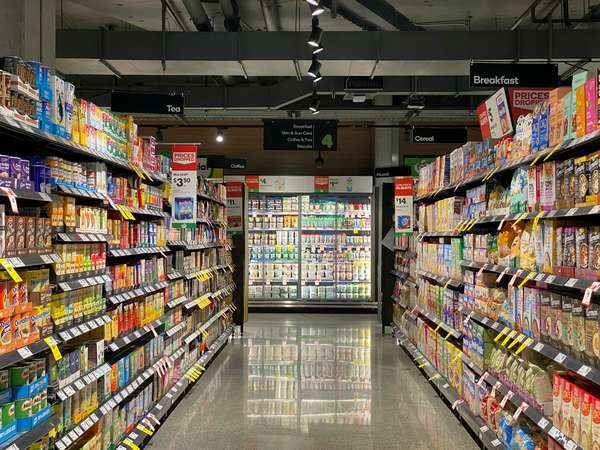
The checkout total keeps climbing, but the pension doesn't. It's a reality hitting Australian seniors particularly hard as grocery costs squeeze household budgets tighter than ever before.
What used to be simple shopping trips have, for many, turned into small battles of choice and sacrifice.
While younger families might cut back on dining out or delay that holiday, seniors on fixed incomes face a more troubling dilemma: choosing between essential foods and other necessities. Across the board, Australians are admitting that basic supermarket staples are vanishing from their trolleys.
The senior spending reality
Seniors spend the least each week at $170 on groceries, followed by Gen X at $190, Gen Z at $222, and Gen Y at $227 per week . While this might suggest seniors are managing well, the reality is more complex. Many are simply buying less, not spending less wisely.
According to Finder's Consumer Sentiment Tracker, 39 per cent of Aussies say their grocery shopping is causing them financial stress, up from 29 per cent three years ago . For seniors on fixed incomes, this stress can be overwhelming when every fortnightly pension payment must stretch further.
Recent pension increases, while welcome, haven't kept pace with rising costs. From 20 September 2025 the maximum full Age Pension increased $29.70 per fortnight for a single person, bringing the maximum payment to $1,178.70 . However, living costs for Age pensioner households rose 1.0 per cent this quarter, driven by an increase in housing costs .
'Age Pensioners are still feeling cost-of-living pressures and need to be supported'
The grocery reality check
Price increases between January 2024 and January 2025 range from 3 per cent for bread to 12.3 per cent for fruit , with food and non-alcoholic beverages rising 1.0 per cent in the latest quarter . Some items traditionally popular with seniors have seen significant increases, making weekly shopping a strategic exercise.
In practice, this has meant real sacrifices. One shopper confessed: 'I find cheese really expensive at the moment. I’m not buying as much cheese.' Another admitted that fresh fish had become a 'special occasion' treat. Even protein staples like steak and salmon have slipped out of reach for many .
Interestingly, while the original article highlighted expensive cheese, data shows you're paying around 2 per cent less for cheese compared to other items . However, the food category hit hardest by inflation in January 2025 was fruit at 12.3 per cent—a staple many seniors rely on for essential vitamins .
The pattern is clear: seniors aren't just cutting luxury items. They're making difficult choices about basics like protein, fresh produce, and dairy—foods critical for healthy ageing.
When cutting costs cuts health
Here's where the grocery squeeze becomes genuinely concerning for seniors. Research shows that protein and dairy aren't just preferences—they're health necessities that become more critical with age.
Studies show each dairy serving was associated with a 1 point increase in nutrition scores, and increasing consumption of dairy foods to the recommended four servings daily ensures protein adequacy and may reduce malnutrition risk in institutionalised elderly .
For seniors, sarcopenia is present in up to 15 per cent of community-dwelling people over 85 years, with functional adverse consequences including increased morbidity due to falls, fractures, infections and other conditions, as well as increased mortality .
Why protein matters more as you age
Several studies have identified protein (especially the essential amino acids) as a key nutrient for muscle health in elderly adults. Elderly adults are less responsive to the anabolic stimulus of low doses of amino acid intake compared to younger individuals. However, this lack of responsiveness in elderly adults can be overcome with higher levels of protein consumption .
A study in the Journal of Nutrition, Health & Aging found that approximately 46 per cent of individuals ages 51 and older didn't meet daily protein recommendations . Lower protein intake makes it more challenging to build muscle mass.
The health costs of cutting these foods can be significant. In the Netherlands, malnutrition costs an estimated €8000 per resident at risk, while in Australia's hospital setting, malnutrition adds about AU$1800 to each admission .
Smart strategies for senior shoppers
The good news? There are effective ways to manage grocery costs without compromising health. As personal finance experts advise, shopping across multiple stores, switching to generic brands, and using loyalty programs consistently can make a difference .
Senior-friendly shopping strategies
- Shop across multiple stores for best deals on staples
- Choose generic brands for significant savings
- Buy frozen fruits and vegetables when fresh is expensive
- Look for senior discount days at local supermarkets
- Consider buying in bulk for non-perishables with neighbours
- Use loyalty programs consistently for rewards
Canned seafood, such as salmon, tuna, or crab, is quick to prepare and enjoy. Canned items also store well—making them excellent protein sources for seniors on budgets .
For those concerned about getting enough protein, a wide variety of foods, both plant- and meat-based, are high in protein, including beans, peas, and lentils; nuts and seeds; lean meats; fish; dairy products; and soy products .
Regional variations matter
Location significantly affects grocery costs for seniors. People in NSW spend the most on groceries, with an average cost of $215 each week, while people in Queensland and South Australia have the lowest average weekly cost of $186 .
The cost of groceries is typically higher in regional and remote areas of Australia, where fewer supermarkets mean there is less competition . Transport to these areas also adds to the cost. For example, groceries are on average 21 per cent to 62 per cent more expensive in remote and regional areas of the NT.
This creates additional pressure for seniors in smaller communities who may already have limited transport options.
Government and community support
Several support measures can help ease the grocery burden for eligible seniors:
Available supports
- The recent pension increase provides some relief
- Many supermarkets offer senior shopping hours with quieter environments
- Local councils often provide community transport to major shopping centres
- Some areas have community gardens where seniors can access fresh produce
The Australian Competition and Consumer Commission (ACCC) is researching supermarket pricing strategies, with findings expected to be released in early 2025, which could influence pricing decisions .
Looking ahead
Grocery prices are unlikely to see a significant drop in 2025, with experts including retail specialist Gary Mortimer from Queensland University of Technology indicating that the cost of a shopping basket will remain high .
However, Mortimer also anticipates that supermarkets will focus on price stability and promotions, potentially offering significant discounts on specific items as a response to public sensitivity over pricing .
Did you know?
Did you know?
The government indexation process considers cost-of-living pressures when adjusting pensions. The September 2025 increase was the largest in two years, reflecting ongoing inflationary pressures affecting all Australians .
For seniors, the key is staying informed about available supports, shopping strategically, and prioritising nutritional needs. While the grocery squeeze is real, there are ways to maintain both budget and health with careful planning.
What This Means For You
The cost-of-living squeeze is real, but it doesn't have to mean compromising on the nutrition that's essential for healthy ageing. With smart strategies and awareness of available supports, seniors can navigate these challenging times while maintaining their health and independence.
What strategies have helped you manage rising grocery costs while maintaining good nutrition? Have you discovered any particularly good deals or community resources that other seniors might benefit from? Share your experiences in the comments below—we'd love to hear your practical tips and perhaps feature them in future articles.
Original Article
https://www.news.com.au/finance/cul...s/news-story/93f7c93c307c5726c4924e1de636dba2
What the average Aussie spends on groceries in 2025 | Finder
Cited text: Baby boomers spend the least each week at $170, followed by Gen X at $190, Gen Z at $222, and Gen Y at $227 per week.
Excerpt: Baby boomers spend the least each week at $170 on groceries, followed by Gen X at $190, Gen Z at $222, and Gen Y at $227 per week
https://www.finder.com.au/budgeting/average-grocery-bill
What the average Aussie spends on groceries in 2025 | Finder
Cited text: According to Finder's Consumer Sentiment Tracker, 39 per cent of Aussies say their grocery shopping is causing them financial stress, up from 29 per cent 3 years ago....
Excerpt: According to Finder's Consumer Sentiment Tracker, 39 per cent of Aussies say their grocery shopping is causing them financial stress, up from 29 per cent 3 years ago
https://www.finder.com.au/budgeting/average-grocery-bill
Age Pension rates (September 2025 to March 2026)
Cited text: ... From 20 September 2025 the maximum full Age Pension increases $29.70 per fortnight for a single person, and $44.80 combined ($22.40 per person) pe...
Excerpt: From 20 September 2025 the maximum full Age Pension increased $29.70 per fortnight for a single person, bringing the maximum payment to $1,178.70
https://www.superguide.com.au/in-retirement/age-pension-rates
Age Pension payment changes—National Seniors Australia
Cited text: The maximum rate of the single-rate Age Pension will rise by $29.70 per fortnight (taking it from $1,149.00 to $1,178.70) and, for couples, by $22.40 ...
Excerpt: From 20 September 2025 the maximum full Age Pension increased $29.70 per fortnight for a single person, bringing the maximum payment to $1,178.70
https://nationalseniors.com.au/news/latest-news/age-pension-payment-changes
Selected Living Cost Indexes, Australia, June 2025 | Australian Bureau of Statistics
Cited text: · Living costs for Age pensioner (+1.0 per cent) and Other government transfer recipient (+1.0 per cent) households and the Pensioner and Beneficiary LCI (PBLCI) (+1....
Excerpt: living costs for Age pensioner households rose 1.0 per cent this quarter, driven by an increase in Housing costs
https://www.abs.gov.au/statistics/e...-living-cost-indexes-australia/latest-release
Selected Living Cost Indexes, Australia, June 2025 | Australian Bureau of Statistics
Cited text: The increase in living costs for these households were driven by an increase in Housing costs.
Excerpt: living costs for Age pensioner households rose 1.0 per cent this quarter, driven by an increase in Housing costs
https://www.abs.gov.au/statistics/e...-living-cost-indexes-australia/latest-release
What the average Aussie spends on groceries in 2025 | Finder
Cited text: If we look at just groceries, price increases between January 2024 and January 2025 range from 3 per cent for bread to 12.3 per cent for fruit.
Excerpt: Price increases between January 2024 and January 2025 range from 3 per cent for bread to 12.3 per cent for fruit
https://www.finder.com.au/budgeting/average-grocery-bill
Consumer Price Index, Australia, June Quarter 2025 | Australian Bureau of Statistics
Cited text: The most significant price rises this quarter were Housing (+1.2 per cent), Food and non-alcoholic beverages (+1.0 per cent) and Health (+1.5 per cent).
Excerpt: food and non-alcoholic beverages rising 1.0 per cent in the latest quarter
https://www.abs.gov.au/statistics/e...consumer-price-index-australia/latest-release
What the average Aussie spends on groceries in 2025 | Finder
Cited text: This means you're paying around 9.5 per cent more for fruit, 9.4 per cent more for oils, 9 per cent more for eggs and 8 per cent more for vegetables, but 2 per cent less for cheese.
Excerpt: data shows you're paying around 2 per cent less for cheese
https://www.finder.com.au/budgeting/average-grocery-bill
What the average Aussie spends on groceries in 2025 | Finder
Cited text: The food category hit hardest by inflation in January 2025 was fruit 12.3 per cent.
Excerpt: the food category hit hardest by inflation in January 2025 was fruit at 12.3 per cent
https://www.finder.com.au/budgeting/average-grocery-bill
Dairy food supplementation may reduce malnutrition risk in institutionalised elderly—PMC
Cited text: Number of dairy servings (P<0·001), but not meat servings increased MNA score; each dairy serving was associated with a 1 point increase in MNA score ...
Excerpt: Studies show each dairy serving was associated with a 1 point increase in nutrition scores, and increasing consumption of dairy foods to the recommended four servings daily ensures protein adequacy and may reduce malnutrition risk in…
https://pmc.ncbi.nlm.nih.gov/articles/PMC5350609/
Dairy food supplementation may reduce malnutrition risk in institutionalised elderly—PMC
Cited text: On the basis of current dietary intakes in aged-care residents, increasing consumption of dairy foods to the recommended four servings daily ensures p...
Excerpt: Studies show each dairy serving was associated with a 1 point increase in nutrition scores, and increasing consumption of dairy foods to the recommended four servings daily ensures protein adequacy and may reduce malnutrition risk in…
https://pmc.ncbi.nlm.nih.gov/articles/PMC5350609/
Rational Use of Protein Supplements in the Elderly ...
Cited text: Sarcopenia is present in up to 15 per cent of community-dwelling people over 85 years [4]. Sarcopenia has functional adverse consequences, with increased morb...
Excerpt: sarcopenia is present in up to 15 per cent of community-dwelling people over 85 years, with functional adverse consequences including increased morbidity due to falls, fractures, infections and other conditions, as well as increased mortality
https://pmc.ncbi.nlm.nih.gov/articles/PMC8068133/
Protein Consumption and the Elderly: What Is the Optimal Level of Intake? - PMC
Cited text: Several studies have identified protein (especially the essential amino acids) as a key nutrient for muscle health in elderly adults. Elderly adults a...
Excerpt: Several studies have identified protein (especially the essential amino acids) as a key nutrient for muscle health in elderly adults.
https://pmc.ncbi.nlm.nih.gov/articles/PMC4924200/
Muscle loss and protein needs in older adults—Harvard Health
Cited text: A study published in the Journal of Nutrition, Health & Aging that looked at the diets of nearly 12,000 individuals ages 51 and older found that appro...
Excerpt: A study in the Journal of Nutrition, Health & Aging found that approximately 46 per cent of individuals ages 51 and older didn't meet daily protein recommendations.
https://www.health.harvard.edu/staying-healthy/muscle-loss-and-protein-needs-in-older-adults
Dairy food supplementation may reduce malnutrition risk in institutionalised elderly—PMC
Cited text: The annual cost of malnutrition in institutionalised elderly in the Netherlands is estimated at €8000 (approximately US$9000) for each resident at ris...
Excerpt: In the Netherlands, malnutrition costs an estimated €8000 per resident at risk, while in Australia's hospital setting, malnutrition adds about AU$1800 to each admission
https://pmc.ncbi.nlm.nih.gov/articles/PMC5350609/
MyPlate.gov | Nutrition Information for Older Adults
Cited text: Canned seafood, such as salmon, tuna, or crab, is quick to prepare and enjoy. Canned items also store well.
Excerpt: Canned seafood, such as salmon, tuna, or crab, is quick to prepare and enjoy. Canned items also store well
https://www.myplate.gov/life-stages/older-adults
Muscle loss and protein needs in older adults—Harvard Health
Cited text: A wide variety of foods, both plant- and meat-based, are high in protein. These include beans, peas, and lentils; nuts and seeds; lean meats; fish; da...
Excerpt: a wide variety of foods, both plant- and meat-based, are high in protein, including beans, peas, and lentils; nuts and seeds; lean meats; fish; dairy products; and soy products
https://www.health.harvard.edu/staying-healthy/muscle-loss-and-protein-needs-in-older-adults
What the average Aussie spends on groceries in 2025 | Finder
Cited text: So far for February 2025, people in NSW spend the most on groceries, with an average cost of $215 each week based on data from Finder's Consumer Senti...
Excerpt: People in NSW spend the most on groceries, with an average cost of $215 each week, while people in Queensland and South Australia have the lowest average weekly cost of $186
https://www.finder.com.au/budgeting/average-grocery-bill
What the average Aussie spends on groceries in 2025 | Finder
Cited text: The cost of groceries is typically higher in regional and remote areas of Australia, where fewer supermarkets mean there is less competition. Transpor...
Excerpt: The cost of groceries is typically higher in regional and remote areas of Australia, where fewer supermarkets mean there is less competition.
https://www.finder.com.au/budgeting/average-grocery-bill
Prices are soaring—here’s what you need to know about your grocery bill in 2025! | Seniors Discount Club
Cited text: One of the reasons for this potential price stabilisation is the Australian Competition and Consumer Commission's (ACCC) ongoing probe into the pricin...
Excerpt: The Australian Competition and Consumer Commission (ACCC) is researching supermarket pricing strategies, with findings expected to be released in early 2025, which could influence pricing decisions
https://seniorsdiscountclub.com.au/...to-know-about-your-grocery-bill-in-2025.67010
Prices are soaring—here’s what you need to know about your grocery bill in 2025! | Seniors Discount Club
Cited text: The Australian Competition and Consumer Commission (ACCC) is researching supermarket pricing strategies, with findings expected to be released in earl...
Excerpt: The Australian Competition and Consumer Commission (ACCC) is researching supermarket pricing strategies, with findings expected to be released in early 2025, which could influence pricing decisions
https://seniorsdiscountclub.com.au/...to-know-about-your-grocery-bill-in-2025.67010
Prices are soaring—here’s what you need to know about your grocery bill in 2025! | Seniors Discount Club
Cited text: Firstly, let's address the elephant in the room: grocery prices are unlikely to see a significant drop in 2025. Experts, including retail special...
Excerpt: Grocery prices are unlikely to see a significant drop in 2025, with experts including retail specialist Gary Mortimer from Queensland University of Technology indicating that the cost of a shopping basket will remain high
https://seniorsdiscountclub.com.au/...to-know-about-your-grocery-bill-in-2025.67010
Prices are soaring—here’s what you need to know about your grocery bill in 2025! | Seniors Discount Club
Cited text: Experts, including retail specialist Gary Mortimer from Queensland University of Technology, have indicated that the cost of a shopping basket will re...
Excerpt: Grocery prices are unlikely to see a significant drop in 2025, with experts including retail specialist Gary Mortimer from Queensland University of Technology indicating that the cost of a shopping basket will remain high
https://seniorsdiscountclub.com.au/...to-know-about-your-grocery-bill-in-2025.67010
Prices are soaring—here’s what you need to know about your grocery bill in 2025! | Seniors Discount Club
Cited text: Retail expert Gary Mortimer anticipates that supermarkets will focus on price stability and promotions, potentially offering significant discounts on ...
Excerpt: retail expert Gary Mortimer anticipates that supermarkets will focus on price stability and promotions, potentially offering significant discounts on specific items as a response to public sensitivity over pricing
https://seniorsdiscountclub.com.au/...to-know-about-your-grocery-bill-in-2025.67010







